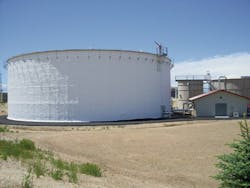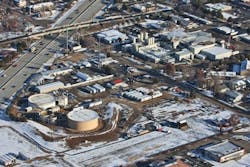About the author: Shannon Grant is president of ADI Systems. Grant can be reached at [email protected] or 800.561.2831.
Above: Darigold in Boise, Idaho, installed a 1.7-million-gal anaerobic reactor to compensate for introducing a cottage cheese line.
Wastewater generated from industrial dairy plants poses many challenges for treatment. Dairy processing wastewater can contain high concentrations of fat, oil, and grease (FOG), which can disrupt the stability of the treatment process, and high concentrations of calcium can cause scaling of the surfaces of treatment tanks, piping and equipment. Cleaning vessels and processing equipment typically is conducted several times per day, resulting in significant changes in hourly flow of wastewater. Furthermore, cleaning and disinfection chemicals may contain compounds that can be toxic to the biomass used in treating the wastewater. Everyday operations at dairy plants can be arduous, so adding a new production line to the mix can complicate the process. Such was the case for Darigold, one of North America’s largest dairy co-operatives.
Whey Too Much Wastewater
In 2009, Darigold’s plant in Boise, Idaho, was preparing to install a cottage cheese production line. The plant expansion resulted in organic load substantially increasing from 4,600 lb chemical oxygen demand per day (COD/d) to 23,400 lb COD/d. A significant portion of the increase in organic load was attributed to the high-strength whey derived from the new cottage cheese production line. To address the change, Darigold’s wastewater pre-treatment system needed to be expanded.
Nearly 15 years earlier, ADI Systems had designed and constructed a wastewater system for Darigold. This system consisted of one 120,000 gal equalization tank, a 1 million gal anaerobic reactor, and a conventional activated sludge system consisting of one 213,000 gal aeration tank and tank clarifier to aerobically polish the anaerobic effluent prior to final discharge.
As part of Darigold’s expansion, ADI Systems designed and installed a new 1.7-million-gal anaerobic reactor to operate in parallel with the existing reactor. The project included tank internals, a recycle pumping system, a geomembrane tank cover, and interconnecting piping to the existing reactor and activated sludge system. ADI Systems also upgraded the biogas transmission system, aeration system, and control programming in order to accommodate the increases in hydraulic and organic load sent to the treatment system.
The Darigold expansion increased the plant’s chemical oxygen demand per day from 4,600 to 23,400 lb.
Going Through the Motions
Darigold’s wastewater is pumped to the equalization tank from a pumping station beneath the street next to the dairy facility. The EQ tank blends, attenuates and buffers the raw wastewater temperature, pH, COD concentration and various cleaning chemicals contained in the wastewater.
Wastewater is then pumped from the equalization tank to the anaerobic reactors, which digest the majority of the raw organics present in the wastewater. Flow meters and flow control valves split the influent flow to each reactor in proportion to the reactor volumes.
Aside from coarse pre-screening to protect the influent distribution piping, no pre-treatment is required for the influent solids; the raw suspended solids are fed to the reactor, and the long solids retention time (SRT) provides adequate time to destruct the degradable solids and FOG. This eliminates the need for a primary dissolved air flotation unit, skimming tank, grease trap and other typical pre-treatment stages for total suspended solids (TSS) and FOG removal, simplifying the overall process.
Effluent from the reactors flows by gravity to the aeration tank of the activated sludge system. A jet aeration system supplies mixing and aeration for BOD removal and sulfide oxidation.
hen, the mixed liquor from the aeration tank is discharged to a tank clarifier. Settled clarifier solids are typically sent to the aeration tank via the return activated sludge or waste activated sludge (WAS) pump. The WAS is pumped to the EQ tank to maintain the mixed liquor suspended solids concentration within a target range of 2,500 to 5,000 mg/L.
Final effluent is discharged from the tank clarifier to the West Boise Sewer District sanitary sewer.
The ultimate result is high-quality effluent and money-saving biogas. The anaerobic digestion process naturally produces biogas that can be used to generate process heat or electricity, helping to offset energy costs. The geomembrane covers on the reactors collect the biogas, preventing methane from escaping into the atmosphere, thereby minimizing harmful greenhouse gases. These insulated covers also provide odor control and temperature control to reduce the need for supplemental heat to be added to influent wastewater.
Treating Wastewater Right
The low-rate anaerobic digester was installed in time for the Darigold plant to ramp up production and proceed with its cottage cheese line as planned. The combination of the reactors and the activated sludge technology is still producing high-quality effluent, even when hydraulically overloaded. The system typically removes 96% to 98% of the influent COD load, with more than 90% being removed by the reactors, which serve as the workhorse of the entire system.
The long retention time associated with the reactors ensures that FOG in the raw wastewater and WAS from the downstream aerobic polishing system are properly digested. With a proper solids management strategy, anaerobic biosolids can be disposed as infrequently as twice per year, which Darigold does in the spring and fall.
Darigold can deposit biosolids directly from the anaerobic reactors to tanker trucks without dewatering. The biosolids are then land-applied as liquid fertilizer due to their high nutrient content. Darigold’s expanded pre-treatment system consistently discharges a high-quality effluent to the West Boise Sewer District that easily meets the objectives for COD and TSS. The upgraded wastewater treatment system requires little energy to operate, further minimizing overall operating costs. Minimal moving parts within the reactor and easy access features for sampling and maintenance within the cover, result in low maintenance requirements for the operators.
The low food-to-microorganism ratio, long hydraulic retention time, SRT, and adequate feeding, mixing, and recycle arrangement provide enhanced process stability and the ability to handle swings and peaks in hydraulic and organic loads. Handling these peaks is important for plants treating dairy wastewater, since in-plant cleanings can result in significant changes to hourly flow and organic load discharged to the pre-treatment plant.
The system’s long-term successful performance demonstrates the ability of the low-rate anaerobic reactors to handle dairy wastewater components that can be troublesome for alternative treatment technologies. More specifically, the high influent TSS concentrations, high FOG concentrations and potentially harmful compounds discharged via the sanitizing and disinfecting chemicals (e.g., hydrogen peroxide, peracetic acid, etc.) have not been a detriment to Darigold’s solution.

